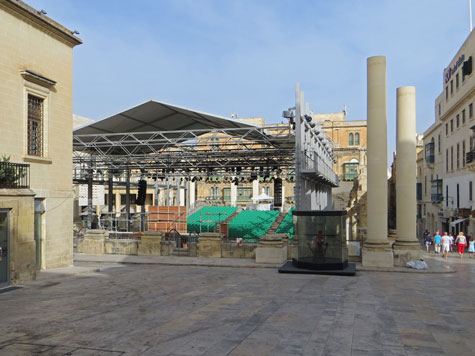

The city took his name and was called La Valletta. The victorious Grand Master, Jean de Valette, immediately set out to build a new fortified city on the Sciberras Peninsula to fortify the Order's position in Malta and bind the Knights to the island. In the Great Siege of 1565, Fort Saint Elmo fell to the Ottomans, but the Order eventually won the siege with the help of Sicilian reinforcements. In 1552, the Aragonite watchtower was demolished and the larger Fort Saint Elmo was built in its place. Back then, the only building on the peninsula was a small watchtower dedicated to Erasmus of Formia (Saint Elmo), which had been built in 1488. The building of a city on the Sciberras Peninsula had been proposed by the Order of Saint John as early as 1524. The city is noted for its fortifications, consisting of bastions, curtains and cavaliers, along with the beauty of its Baroque palaces, gardens and churches. Valletta is also the sunniest city in Europe.

Sometimes called an "open-air museum", Valletta was chosen as the European Capital of Culture in 2018. Today, with 320 monuments, is one of the most dense monuments areas in the world. The city was officially recognised as a World Heritage Site by UNESCO in 1980. The city is Baroque in character, with elements of Mannerist, Neo-Classical and Modern architecture, though the Second World War left major scars on the city, particularly the destruction of the Royal Opera House. The city was named after Jean Parisot de Valette, who succeeded in defending the island from an Ottoman invasion during the Great Siege of Malta. Valletta's 16th-century buildings were constructed by the Knights Hospitaller. Valletta is the southernmost capital of Europe, and at just 0.61 square kilometres (0.24 sq mi), it is the European Union's smallest capital city. According to the data from 2020 by Eurostat, the Functional Urban Area and metropolitan region covered the whole island and has a population of 480,134. Located on the main island, between Marsamxett Harbour to the west and the Grand Harbour to the east, its population within administrative limits in 2014 was 6,444. "33c a day to get opera house back." Times of Malta, 25 February 2010.Valletta ( / v ə ˈ l ɛ t ə/, Maltese: il-Belt Valletta, Maltese pronunciation: ) is the administrative unit and capital of Malta. Sesto Florentino (Fi): Centro Stampa Editoriale (Plurigraf), 2003. Maltese-English Dictionary of Architecture and Building in Malta. "Barry, Edward Middleton (1830-1880)" Oxford Dictionary of National Biography. The latest idea is for an open-air theatre, but there is also a plan to raise funds for a fine state-of-the-art 800-seat theatre with a roof (Johnston). So far, proposals to rebuild it have been unsuccessful fortunately, so has the proposal to turn the area into a multi-storey car park. The bombed-out building makes a sad sight now.

Jesmond Grech writes that "it gave an invaluable boost to the artistic and cultural lives of the Maltese" (41). Rightly numbered among his "distinguished works" (Burnet and Blissett), the building had over a thousand seats and was in a very prominent position just inside the city gate at the top of Republic Street: it must have been extraordinarily impressive. Caption and commentary by Jacqueline Banerjee.Īfter his success with the Royal Opera House in Covent Garden, London, Barry was asked to design a grand opera house for the capital of Malta, Valletta. Scan by Andreas Praefcke, from his fine collection of theatre postcards at Carthalia. The Royal Opera House, Valletta, Malta, as it once was.


 0 kommentar(er)
0 kommentar(er)
